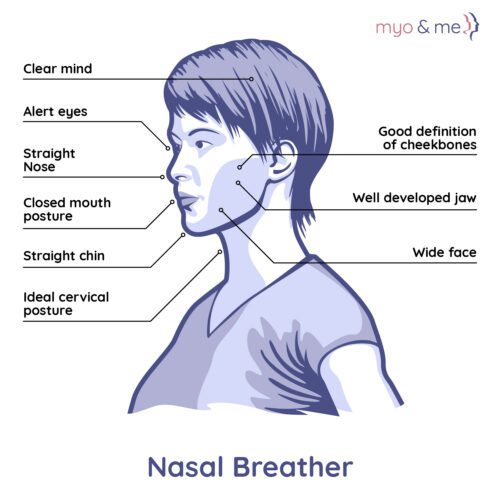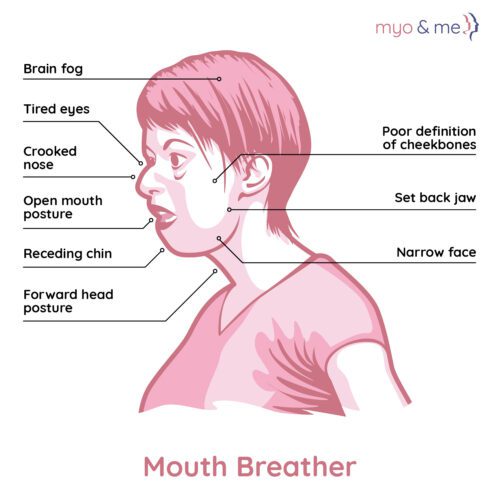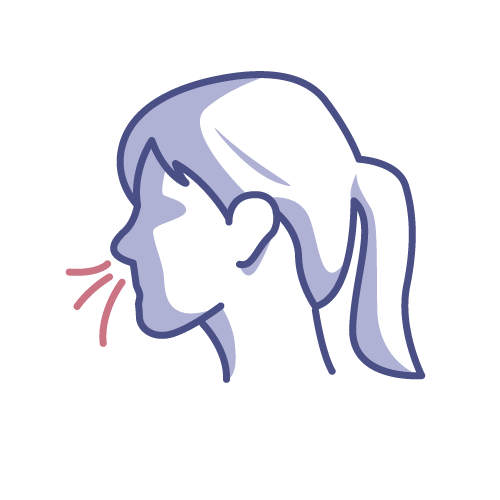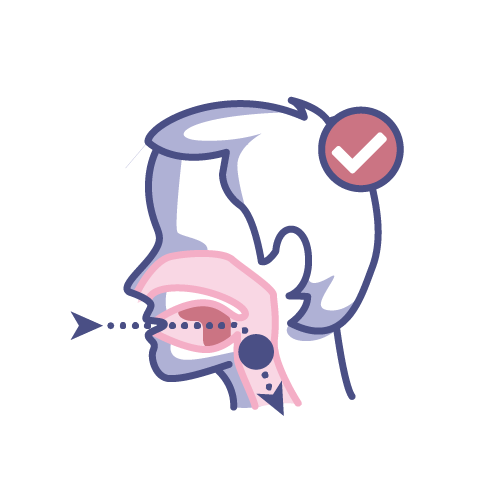About Orofacial Myofunctional Therapy
Orofacial Myofunctional Therapy (OMT) is a form of physical therapy. Orofacial means ‘of the mouth and face’, while Myofunctional means ‘muscle function’. Myofunctional therapy reteaches your orofacial muscles – the muscles of your head and neck area – how they should work and behave, to correct any bad habits that have formed.
You gain muscle memory by repeating the same activity many times, like when you play sports or type on a keyboard. Myofunctional therapy does this for a targeted set of oral and facial muscles. This is a gradual process and is best delivered through a course of therapy that is tailored to the individual.
Myo and Me empowers patients to form new healthy habits. We work in partnership with our patients, guiding them in performing repeatable, non-invasive exercises that help their muscles to work in an optimal way. Through this, Myofunctional Therapy can help in realising significant improvements in breathing, speaking, chewing and swallowing.
If you would like to find out more about our services and how we work, please do get in touch.
The most common reason why your orofacial muscles might not be working in an optimal way is due to what we call Orofacial Myofunctional Disorders (OMDs) – disorders that predominantly affect your head and neck muscles in a negative way.
OMDs might start as something small and seemingly innocuous but, over time, can lead to habits being formed that result in incorrect muscle function. This can then affect everyday functions like breathing, speaking, oral hygiene, eating, swallowing and, in the case of babies and infants, breastfeeding and/or bottle feeding.
OMDs can have a detrimental effect on how your face looks and, in a growing child, how your facial bones grow and develop. They can affect your bite and how your teeth come together when you close your mouth, as well as any existing dental or speech-related treatments. This can then cause wider issues such as poor posture, so it’s important that we aim to prevent, treat and resolve symptoms of OMDs to minimise their impact on your body and overall health.
The image below highlights some of the effects mouth breathing can have on appearance, and what a change to nasal breathing can bring:

Some common causes of OMDs include:
– Nasal congestion (due to allergies, rhinitis etc.) that leads to mouth breathing
– ‘Everyday’ oral habits such as thumb sucking, nail biting etc.
– Improper chewing/swallowing habits
– Long term use of a dummy, bottles or sippy cups
– Over (or under) active oral muscles
– Enlarged tonsils/adenoids
– Oral restrictions, including lip and/or tongue ties
– Underlying genetics
– Pre-term or traumatic birth
– Diet, in particular regular consumption of pureed or processed foods
If any of the above are affecting you or a loved one, then therapy could provide a way to minimise and resolve them.
Many patients suffering from OMDs have restricted tongue movement, which can have a significant effect on feeding, speaking and swallowing. This can often be due to a ‘tie’, caused by a restrictive string-like tissue under the tongue. Not all oral restrictions are obvious without knowing what you’re looking for, and so many patients can go a long time – in many cases all their life – without being aware of one.
For more information, please visit our Conditions we Treat page.
Our patients often see a number of benefits as they complete therapy. The four main goals of Myofunctional Therapy are to achieve:
– Nasal breathing, day and night
– Proper resting position of the tongue within the mouth
– A closed mouth/lip seal at rest and whilst chewing
– A correct swallowing pattern
We work with patients to realise these goals and see significant improvements such as:
– A feeling of ‘easier’ overall breathing
– A reduction in the severity of sleep-disordered breathing problems
– Better chewing and swallowing
– Increased range of motion in the tongue and jaw
– Less tension and improved posture
Patients are far more likely to achieve these if there’s full commitment to completing the exercises during Myofunctional Therapy.
There is increasing evidence that Myofunctional Therapy can bring positive benefits, particularly to posture, swallowing, breathing and other oral functions. It can also play a key part in reducing more significant conditions such as sleep apnea, particularly when applied in conjunction with other treatments.
We treat adults and children from 2 years old. We tend to see greater results from therapy in children, as their bones and muscles are still developing. However, it is also very effective for adults, particularly those suffering from OMDs.
We are unfortunately unable to offer Orofacial Myofunctional Therapy to children under 2 years old. Myofunctional Therapy isn’t something that is ‘done to’ someone – it requires a partnership between patient and therapist, and the ability of the patient to perform and repeat the exercises themselves independently. This needs a level of cooperation and understanding that naturally can be difficult to attain with infants under 2 years old.
There is significant orofacial muscle development in younger children and so it is imperative to encourage the formation of the right oral habits from an early age. We offer an Infant Orofacial Assessment that assesses the current function of the child’s orofacial muscles and provides tailored guidance to support your child as they continue to grow.
About Our Services
Before any therapy can begin, we need to assess you. For all new patients, we hold a one hour in-person Initial Myofunctional Assessment to understand more about you, your lifestyle, medical history, diet and other relevant information such as how you sleep, and your oral hygiene and health. The assessment helps us identify if there are any myofunctional disorders or areas that may require greater focus during therapy, or if a referral is required to a clinician in an allied field. You’ll receive a report following the Assessment that summarises what we cover as part of the session.
If there is a time lapse after this assessment, we will need to perform a shorter Follow-up Assessment as changes can occur in the musculature and structure of the head and neck. Any changes will need to be checked and considered to ensure the proposed therapy plan is still the right one for you.
We are based in South London, with therapy rooms in Clapham and Wimbledon.
Myofunctional Assessments are held in-person. We hold therapy sessions virtually but in-person appointments may be recommended as an exception in a small number of cases.
For more information, please visit our Treatments page.
At Myo & Me, our therapy is offered as an initial package of 6 sessions. Session lengths vary depending on the age and ability of the patient but usually these are 30-minute sessions. Sessions are spaced two weeks apart to allow more time for practice between appointments. This also allows the therapist to monitor progress over a longer period of time.
If a patient has an oral tie that requires a release (known as a frenectomy), further sessions will be required in addition to the recommended therapy package. As part of these sessions, we will prepare you for the frenectomy by talking through what to expect in an age-appropriate way, as well as preparing the mouth itself through targeted exercises. We also provide post-operative support following the procedure.
Some patients may benefit from a longer course of therapy. Where recommended, we will discuss the potential need for further therapy sessions at the end of the initial package.
At the start of therapy, you’ll be provided with a toolkit to use when performing some of the myofunctional exercises. At each therapy session you’ll be given a set of exercises to perform over the following week(s). We’ll show you how to complete each exercise and talk about how they will support the ‘re-education’ of your muscles. Through the exercises, we are coaching the orofacial muscles to function in the right way and establish these new habits as a new ‘normal’. For our younger patients, we bring the myofunctional exercises to life through games and a fun-based approach to therapy.
The exercises need to be performed multiple times every day. They are all non-invasive; they can be challenging at first, but all are designed to be achievable with practice. The key is that, because they’re relatively simple and don’t take long to do, they’re repeatable – this is what helps to retrain your head and neck muscles, and build muscle memory.
We then review how you’ve got on at the following session to assess progress, talk through any questions and work through your next set of exercises. As the therapy progresses, we aim to see a positive change in the tone, strength and function of your orofacial muscles, as well as your breathing, eating and resting habits. Patients need to be actively engaged in their own treatment to realise these changes, as completing the exercises does require commitment and perseverance.
At the end of the course of therapy, we hold a review to understand your progress against the baseline captured in the Initial Assessment. During this review we gather your feedback, refresh your photographs and talk about how to maintain the newly-learned habits, all of which are summarised in a personalised report. For some patients, we will discuss the potential need for any additional therapy during the review session.
We strongly discourage any breaks in therapy, as this can undo a lot of the good work being achieved.
If you have a break from therapy, or don’t take up therapy soon after the Initial Assessment, we will need to re-baseline your facial musculature and structure. The detail we need to go into will depend on how long it has been since your assessment or last therapy session, or if there have been any other factors or events that have had a significant impact on these muscles.
Where required, we can recommend a network of clinicians including those with a specialism/special interest in releasing oral ties, ENT and respiratory consultants, as well as speech and language therapists, osteopaths and dentists.
The four goals of Myofunctional Therapy

Nasal breathing, day and night
Proper resting position of the tongue in the mouth
A closed mouth/lip seal at rest and while chewing

